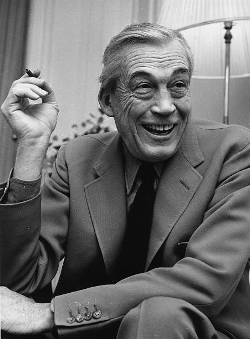 No one burst into cinema like Huston. His first film was a masterpiece, his greatest, and the best first film of any director. He arose as the perfect director, and for ten years he defined genius behind the camera. Far more of a rebel than Welles, he squeezed art out of Hollywood against its will. He had ten years like few others.
No one burst into cinema like Huston. His first film was a masterpiece, his greatest, and the best first film of any director. He arose as the perfect director, and for ten years he defined genius behind the camera. Far more of a rebel than Welles, he squeezed art out of Hollywood against its will. He had ten years like few others.
There’s that old line about the candle that burns brightest?
Huston was known to live wildly, selfishly, and cruelly. He was also thought to be a great deal of fun if you were the right person, which no doubt is in part due to his hard-living ways. As a young(ish) man, attacking life, he filled his films with a reckless power and his vision of what could be, as well as the sins that men are prone to. He lost that in later years, when mortality was on his mind, along with regret, and the strength seemed to drain from his work.
It is strange to see a director whose films looked so beautiful early on and end up looking like TV movies. He worked with some of the best cinematographers in his first ten years (Arthur Edeson, Jack Cardiff) while he ended his career with the guy who shot Freddy vs. Jason.
His greatest successes were with Humphrey Bogart, who he directed six times (and wrote the screenplay for an additional two films). Five of those make my list of Huston’s best; it would be six if I was counted the writing-only gigs as High Sierra would come in around 6th.
An honorable mention for Prizzi’s Honor (1985), which doesn’t hold up as a whole, but the scenes with his daughter, Anjelica, are gold. And one for Moby Dick (1956), which had a too young Gregory Peck forced upon him by the studio (Huston himself would have been better in the part) and never achieves greatness, but is probably as good a film as will be made from the classic and complex novel. And finally an honorable mention to his attempt at a counterculture poem, A Walk with Love and Death (1969); it isn’t good, but it is interesting.
His eight best:
#8 – The List of Adrian Messenger (1963) — A spy who-done-it that is remembered mainly for its many disguised cameos. Watching it is all about trying to figure out if some odd looking character is really a star under layers of makeup. It’s not a top notch film, but fun.
#7 – The Asphalt Jungle (1950) — Huston had made beautiful, nightmare Noirs. Here he made a bleak, gritty one, with weak, stupid people doing weak, stupid things, and it’s hard to look away. (Full review)
#6 – Across the Pacific (1942) — Huston reunites with Humphrey Bogart, Mary Astor, and Sydney Greenstreet to try and recapture the magic. This is no The Maltese Falcon, but for a war-time, spy, propaganda film, it’s about as good as they get. Astor is a decade too old for her girlish beauty role (they really should have changed the line about her being a nineteen-year-old’s dream), but the chemistry is there. It is a shockingly non-racist film for the time.
#5 – Key Largo (1948) — Another collaboration with Lauren Bacall and Humphrey Bogart. As good as Bogart is, it is Edward G. Robinson, in one of his two best performances, and Claire Trevor who really nail this one. Both, in different ways, are so sad. [Also on the Best Actors lists for Humphrey Bogart and Edward G. Robinson]
#4 – The Man Who Would Be King (1975) — His one great film of his last thirty years. Perhaps it was because Huston planned the film in the ‘50s when his thinking was still vibrant. Sean Connery and Michael Caine play former soldiers and conmen who go into hard to reach lands and one is made the god-king of the local tribe. It’s a reminder of what Huston once had done.
#3 – The African Queen (1951) — John Huston and Bogart could do no wrong. Bogart’s only Academy Award and well deserved. Basically a two person show with him and Katherine Hepburn. [Also on the Best Actors lists for Humphrey Bogart and Katherine Hepburn]
#2 – The Treasure of the Sierra Madre (1948) — Huston and Bogart team up yet again in a stunning movie that tackles the nature of greed and evil. Brilliant from start to finish. This is where the “stinkin’ badges” line comes from. [Also on the Best Actors list for Humphrey Bogart]
#1 – The Maltese Falcon (1941) — A film that changed history. Great actors giving great performances with a great director and a great script and great themes. Damn! The camera work is the best I’ve ever seen, and that ranks about 7th on the list of why this movie is wonderful. (Full Critique) [Also on the Best Actors list for Humphrey Bogart]